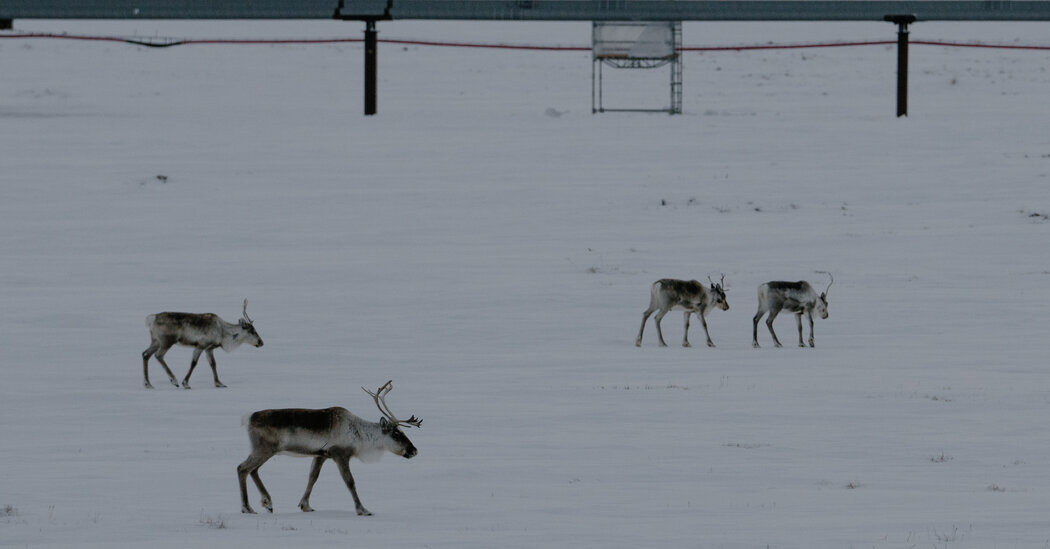
The Trump administration announced Thursday that oil and gas drilling would be allowed in a fragile expanse of tundra and wetlands in northern Alaska that is home to caribou, grizzly bears and thousands of migratory birds.
The move reverses actions taken during the Biden administration to restrict development in half of the National Petroleum Reserve-Alaska, 23 million acres of federal land in the North Slope. Despite having “petroleum” in its name, the expanse is some of the last remaining pristine wilderness in the country and contains some of the most important wildlife habitat in the Arctic.
The administration said in June that it planned to open the reserve to drilling and mining; Thursday’s announcement was the final step. Interior Secretary Doug Burgum said it would “unlock Alaska’s energy potential, create jobs for North Slope communities and strengthen American energy security.”
It was the latest in a series of the Trump administration’s aggressive efforts to expand fossil fuel production in the United States. Last month, the government finalized plans to open the coastal plain of the Arctic National Wildlife Refuge in Alaska to oil and gas drilling. In the coming days, the Interior Department is also expected to propose opening vast new stretches of federal waters to oil and gas development, including areas off the coast of California.
Oil industry advocates and Alaska lawmakers celebrated Thursday’s announcement, which returns the reserve to regulations originally established in 1977. While the action does not entirely eliminate protections for certain areas, it makes it significantly easier to permit drilling and mining.
Gov. Mike Dunleavy, a Republican, called it “yet another step in the right direction for Alaska and American energy dominance.” Senator Dan Sullivan, Republican of Alaska, called it “a new day filled with opportunity for Alaskans.”
Environmental groups, which are expected to challenge the changes in court, said the Trump administration plan could lead to irreversible destruction of land and wildlife.
“Today’s action is another example of how the Trump administration is trying to take us back in time with its reckless fossil fuels agenda,” Erik Grafe, a lawyer with Earthjustice, an environmental nonprofit group, said in a statement.
Monica Scherer, senior director of campaigns at the Alaska Wilderness League, accused the Interior Department of ignoring thousands of public comments it had received since June that were opposed to drilling in the reserve.
“By dismantling these protections, Interior isn’t ‘restoring common sense,’” she said. “It’s sidelining science and traditional knowledge, silencing communities and putting irreplaceable lands and wildlife at risk.”
The National Petroleum Reserve-Alaska sits about 600 miles north of Anchorage, bounded by the Chukchi Sea to the west and the Beaufort Sea to the north. It is the largest single tract of public land in the United States.
Created in the early 1900s, the reserves were originally envisioned as an emergency fuel supply for the Navy. But in 1976, Congress authorized full commercial development of the federal land and ordered the government to balance oil drilling with conservation and wildlife protection.
The Biden administration sought to protect the region’s grizzly and polar bears, caribou and migratory birds by banning drilling on 13 million acres of the reserve last year. At the time, it said it was responding to concerns from Alaska Native communities that have relied on the land, water and wildlife to support their way of life for thousands of years.
The Biden administration said its actions would form a “firewall” against both future fossil fuel development and the expansion of existing projects on the North Slope.
Alaska Native groups have been divided over opening the North Slope to more oil and gas development. The region is both deeply threatened by climate change and dependent on oil for jobs.
Some said on Thursday that they believed the move would help local economic development.
“Today’s action by the federal government is further evidence that it appreciates the importance of North Slope Inupiaq self-determination,” said Nagruk Harcharek, president of Voice of the Arctic Inupiat, which represents Inupiat leadership organizations on the North Slope and supports oil and gas projects.
Emissions from the burning of fossil fuels are the main driver of climate change, which is dangerously heating the planet. Alaska is warming at a rate two to three times as fast as the rest of the United States, resulting in thawing permafrost and melting sea ice. The rising temperatures are also disrupting the hunting, fishing and food-gathering practices of Indigenous communities.
Lisa Friedman is a Times reporter who writes about how governments are addressing climate change and the effects of those policies on communities.
The post Trump Administration Revokes Biden Ban on Drilling and Mining in Alaska Wilderness appeared first on New York Times.



